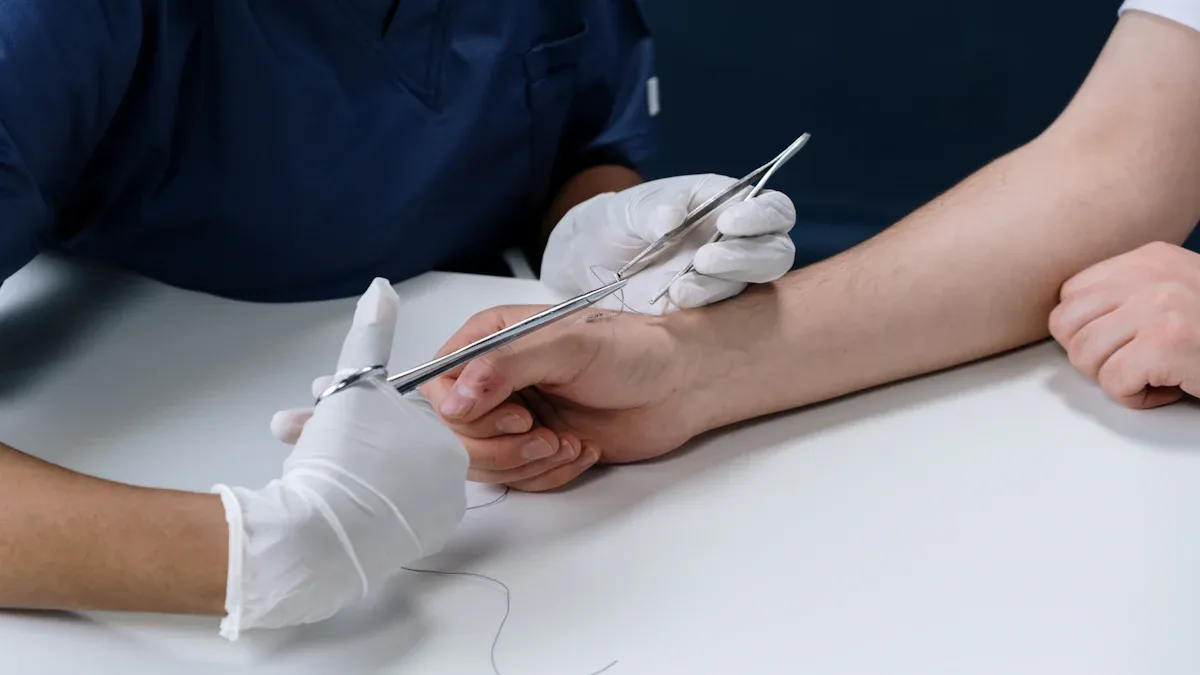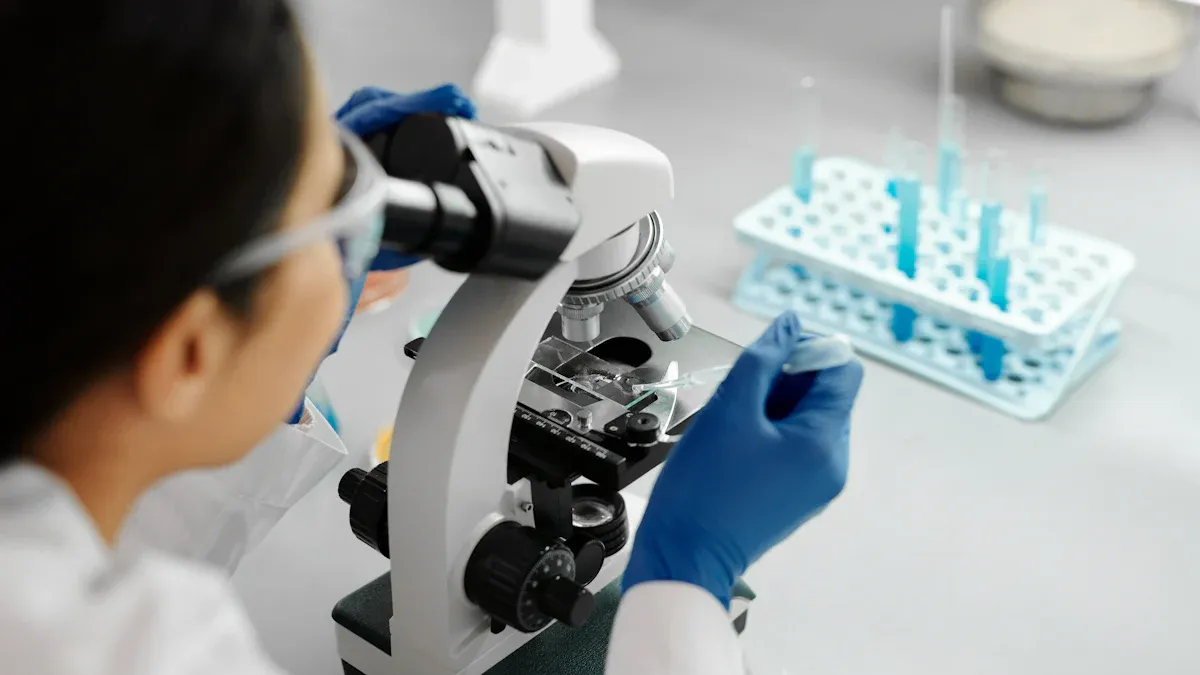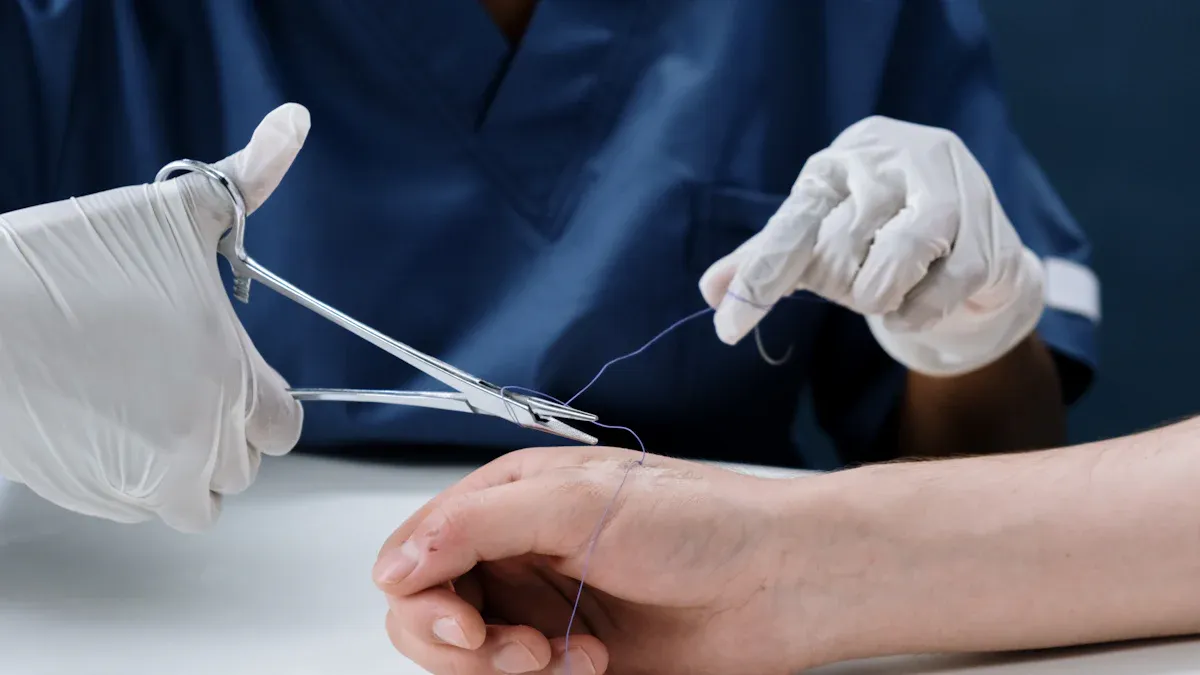Applications of Nitinol Tubing in Stent Manufacturing Explained

Nitinol tubing for stents plays a pivotal role in the production of cardiovascular devices, revolutionizing the field. Its extraordinary properties, including superelasticity, shape memory, and biocompatibility, make it essential for medical applications. For instance, nitinol tubing for stents adapts seamlessly to the dynamic nature of blood vessels, ensuring safety and reliability. Studies confirm its biocompatibility for safe medical use, with ASTM F2129 testing verifying its resistance to corrosion. With nearly 20% of coronary artery disease-related deaths in the U.S. in 2020, nitinol tubing for stents offers life-saving solutions in coronary and peripheral artery treatments. This innovation supports minimally invasive surgical tools like catheters and guidewires.
Key Takeaways
Nitinol tubing can bend and return to shape. This helps stents fit blood vessels, keeping blood flowing well and lowering risks.
Nitinol tubing is safe for the body and doesn’t rust. This reduces bad reactions and helps patients heal faster.
Nitinol tubing is strong and lasts a long time. This means stents work well for years, avoiding extra surgeries.
Nitinol tubing can be made in special shapes. This makes stents fit better in the body and work better for patients.
New ideas like dissolving stents and smart tools are changing heart care, making treatments better for patients.
Unique Properties of Nitinol Tubing for Stents

Superelasticity and Shape Memory
Nitinol tubing stands out in stent manufacturing due to its remarkable superelasticity and shape memory. These properties allow nitinol tubing to recover its original shape after deformation, making it ideal for applications in dynamic environments like blood vessels. When compressed during stent deployment, nitinol tubing expands to conform to the vessel's shape, ensuring a secure fit. This adaptability minimizes the risk of complications and enhances the performance of nitinol stents.
Key Benefits of Superelasticity and Shape Memory:
Enables stents to expand and contract with blood vessels, maintaining proper blood flow.
Reduces the need for additional surgical interventions by ensuring long-term stability.
Enhances patient outcomes by providing a reliable and durable solution for cardiovascular conditions.
Scientific studies confirm that nitinol tubing for stents exhibits exceptional flexibility and durability, making it indispensable for cardiovascular applications. Manufacturing techniques, such as thermomechanical processing, further optimize these properties, ensuring the reliability of nitinol tubing for cardiovascular stents in medical devices.
Biocompatibility and Corrosion Resistance
Biocompatibility is a critical factor in stent manufacturing, and nitinol tubing excels in this area. Its ability to integrate seamlessly with the human body reduces the risk of adverse reactions, such as inflammation or rejection. Additionally, nitinol tubing offers excellent corrosion resistance, ensuring long-term performance even in the harsh environment of the bloodstream.
Note: Biocompatibility and corrosion resistance are essential for ensuring patient safety and the longevity of medical devices like stents.
Why Biocompatibility Matters:
Minimizes the risk of immune responses or allergic reactions.
Promotes faster healing and recovery for patients.
Enhances the overall safety profile of nitinol stents.
ASTM F2129 testing has verified the corrosion resistance of nitinol tubing, making it a trusted material for medical devices. This combination of biocompatibility and corrosion resistance ensures that nitinol tubing remains a top choice for stent manufacturers worldwide.
Durability and Fatigue Resistance
Durability is a cornerstone of nitinol tubing's success in stent manufacturing. Stents must withstand millions of cycles of expansion and contraction without failure, and nitinol tubing delivers exceptional performance in this regard. Its high fatigue resistance ensures that stents remain functional over extended periods, even under challenging conditions.
Test Type | Description |
|---|---|
Cyclic Fatigue Tests | Evaluates the fatigue resistance of stent-like specimens from nitinol tubing. |
Pulsatile Fatigue Tests | Simulates 10 million cycles to assess the durability of nitinol stents. |
Finite Element Analysis | Predicts in vivo fatigue resistance using strain-life diagrams. |
These tests demonstrate the reliability of nitinol tubing under normal stent operating conditions. The material's ability to endure high-cycle fatigue makes it a preferred choice for stent applications, ensuring long-term reliability and improved patient outcomes.
Nitinol tubing's durability and high fatigue resistance make it a game-changer in cardiovascular treatments. Its ability to maintain structural integrity over time reduces the likelihood of complications, offering peace of mind to both patients and healthcare providers.
How Nitinol Tubing Functions in Stents
Expansion and Conformity to Blood Vessels
Nitinol tubing plays a vital role in ensuring stents expand and conform seamlessly to blood vessels. Its unique superelasticity and shape memory properties allow it to adapt to the dynamic environment of the human body. When deployed, nitinol tubing expands to match the vessel's diameter, maintaining vessel patency and ensuring proper blood flow. This adaptability reduces the risk of complications, such as restenosis or stent migration.
Tip: The shape memory effect of nitinol ensures that stents return to their pre-programmed shape after deployment, providing optimal support to the vessel walls.
Several technical assessments validate the performance of nitinol tubing in stents:
Thermal cycling tests confirm its dimensional stability under temperature fluctuations.
Fatigue testing demonstrates its ability to endure over 10⁷ cycles of mechanical stress.
Corrosion resistance tests in physiological solutions verify its structural integrity and biocompatibility.
Tensile strength evaluations show that nitinol can withstand stress levels between 500 MPa and 900 MPa without losing its shape memory.
These properties make nitinol tubing for cardiovascular stents a reliable choice for maintaining vessel patency and improving patient outcomes.
Adaptability to Patient-Specific Needs
Nitinol tubing offers unmatched adaptability, making it ideal for patient-specific applications. Its ability to conform to complex anatomical structures ensures that stents fit precisely, even in challenging cases. Advances in rapid prototyping techniques have further enhanced the customization of nitinol tubing, enabling the creation of individualized implants tailored to unique patient anatomies.
Research highlights the importance of material cleanliness and processing techniques in improving the fatigue life of nitinol tubing. These advancements ensure that stents remain effective over time, even under high mechanical stress. For example, a proof-of-concept study demonstrated the feasibility of creating a patient-specific atrial occluder using nitinol, showcasing its versatility in adapting to intricate anatomical shapes.
This adaptability extends beyond stents to other medical devices, such as nitinol guidewires, which navigate complex vascular pathways with ease. By addressing patient-specific needs, nitinol tubing enhances the efficacy of cardiovascular treatments and supports better clinical outcomes.
Minimizing Vessel Trauma During Deployment
Nitinol tubing minimizes vessel trauma during stent deployment, ensuring a safer and more effective procedure. Its low coefficient of friction reduces the risk of vessel wall injury, while its thin strut design lowers the likelihood of restenosis. These features make nitinol tubing an excellent choice for self-expanding stents, which gently conform to the vessel walls without causing significant damage.
Studies emphasize the importance of stent design in reducing trauma. Computational models, such as finite element analysis, simulate nitinol tubing behavior in patient-specific scenarios, ensuring precise deployment. Additionally, noble metal coatings on nitinol tubing enhance biocompatibility by reducing platelet activation and thrombosis formation, further minimizing complications.
The ability of nitinol tubing to reduce vessel trauma not only improves patient safety but also shortens recovery times. Its innovative design and material properties make it a cornerstone of modern stent manufacturing, offering a reliable solution for cardiovascular interventions.
Advantages of Nitinol Tubing in Cardiovascular Stents

Enhanced Flexibility and Performance
Nitinol tubing offers unmatched flexibility, making it a cornerstone in the design of nitinol stents. Its superelasticity allows stents to adapt seamlessly to the natural movements of blood vessels, ensuring consistent performance. This flexibility is crucial for maintaining vessel patency, especially in dynamic cardiovascular environments. Unlike rigid materials, nitinol tubing conforms to the vessel's shape without compromising its structural integrity.
The material's biocompatibility further enhances its performance. By integrating smoothly with the human body, nitinol tubing minimizes adverse reactions, such as inflammation or rejection. This combination of flexibility and biocompatibility ensures that nitinol tubing for cardiovascular stents delivers reliable results in even the most challenging applications.
Reduced Risk of Complications
Nitinol stents significantly lower the risk of complications during and after deployment. Their ability to expand gently reduces vessel trauma, minimizing the likelihood of restenosis. The high fatigue resistance of nitinol tubing ensures that stents can endure millions of cycles of expansion and contraction without failure. This durability translates to enhanced safety for patients, as it reduces the need for repeat procedures.
Additionally, the biocompatibility and corrosion resistance of nitinol tubing play a pivotal role in reducing complications. These properties prevent the formation of blood clots and other adverse reactions, ensuring the long-term success of cardiovascular devices. By addressing these critical factors, nitinol tubing has become a trusted material in medical devices like stents and guidewires.
Long-Term Reliability and Patient Outcomes
Durability and long-term performance are essential for cardiovascular stents, and nitinol tubing excels in both areas. Its ability to withstand mechanical stress over extended periods ensures that stents remain functional for years. This durability reduces the risk of device failure, providing peace of mind to both patients and healthcare providers.
The enhanced long-term reliability and performance of nitinol stents directly contribute to better patient outcomes. By maintaining vessel patency and reducing the risk of restenosis and complications, these stents improve the quality of life for individuals with cardiovascular conditions. The innovative properties of nitinol tubing, combined with its biocompatibility, make it a game-changer in modern cardiovascular applications.
Types of Nitinol Tubing for Stent Manufacturing
Coated vs. Uncoated Nitinol Tubing
Nitinol tubing can be manufactured with or without coatings, depending on the intended application. Coated nitinol tubing often features specialized surface treatments that enhance its biocompatibility and reduce the risk of complications, such as thrombosis. These coatings may include polymers or noble metals, which improve the tubing's interaction with the human body. Uncoated nitinol tubing, on the other hand, relies on its inherent properties, such as corrosion resistance and durability, to perform effectively in medical devices.
Tip: Coated nitinol tubing is ideal for applications requiring enhanced biocompatibility, while uncoated tubing offers a cost-effective solution for simpler designs.
The choice between coated and uncoated nitinol tubing depends on the specific requirements of the stent. For example, coated tubing may be preferred for cardiovascular stents to minimize platelet activation, while uncoated tubing might suffice for guidewires or other minimally invasive tools.
Heat-Treated vs. Non-Heat-Treated Tubing
Heat treatment plays a crucial role in optimizing the mechanical properties of nitinol tubing. Heat-treated tubing undergoes a controlled thermal process that enhances its shape memory, superelasticity, and fatigue resistance. This makes it particularly suitable for stents that must endure dynamic environments, such as the cardiovascular system. Non-heat-treated tubing, while still durable, may lack the refined mechanical properties required for high-performance applications.
Manufacturers often use heat-treated nitinol tubing for stents that demand precise expansion and long-term reliability. Non-heat-treated tubing may be more appropriate for applications where extreme flexibility or fatigue resistance is not critical.
Customizable Tubing for Specific Applications
Customization is a key advantage of nitinol tubing, allowing manufacturers to tailor it to specific medical applications. By adjusting dimensions, mechanical properties, and surface finishes, nitinol tubing can meet the unique demands of complex stent designs. This level of customization ensures better compatibility with patient anatomy and enhances clinical outcomes.
Customization Aspect | Benefit |
|---|---|
Dimensions | Tailored to specific clinical needs |
Mechanical Properties | Enhanced device functionality |
Surface Finishes | Improved compatibility with patient anatomy |
Lead to better patient outcomes in complex vascular conditions |
For example, nitinol tubing can be customized to create stents for intricate cardiovascular procedures or guidewires for navigating challenging vascular pathways. This adaptability highlights the versatility of nitinol tubing in modern medical devices.
Emerging Trends in Nitinol Tubing for Cardiovascular Stents
Development of Bioresorbable Stents
The development of bioresorbable stents represents a groundbreaking advancement in cardiovascular devices. These stents, made from materials like nitinol tubing combined with bioabsorbable polymers, dissolve over time, eliminating the need for permanent implants. This innovation reduces the risk of long-term complications, such as chronic inflammation or restenosis, while improving patient outcomes.
Clinical trials and market reports highlight the growing adoption of bioresorbable stents:
Evidence | Description |
|---|---|
Drug Eluting Stent with Bioabsorbable Polymers | Fully bioresorbable polymers aim to avoid restenosis and enhance clinical outcomes. |
FDA Approvals | Biotronik’s Orsiro and Abbott’s Absorb GT1 have received FDA approval for bioabsorbable stents. |
Market Growth | Rising cardiovascular disease prevalence drives demand for bioresorbable stents. |
The increasing use of nitinol tubing in bioresorbable stents aligns with advances in manufacturing techniques, ensuring these devices meet the highest standards of performance and safety.
Advances in Personalized Stent Designs
Personalized stent designs are transforming the applications of nitinol tubing in cardiovascular treatments. These stents leverage nitinol’s unique properties, such as shape memory and superelasticity, to conform precisely to individual patient anatomies. This adaptability ensures effective treatment for conditions like coronary artery disease and peripheral artery disease.
Nitinol stents compress for insertion and expand to their original size once deployed, ensuring optimal vessel support.
Clinical studies show nitinol stents outperform traditional metal stents, offering better solutions for arterial blockages.
Nitinol’s durability and corrosion resistance contribute to long-term implant performance, reducing replacements and healthcare costs.
Innovations in personalized stent designs, supported by advances in manufacturing techniques, enable the creation of tailored cardiovascular devices that improve patient outcomes and reduce complications.
Integration of Smart Materials and Technologies
The integration of smart materials and technologies into nitinol tubing is revolutionizing stent manufacturing. Smart stents equipped with sensors can monitor blood flow and detect early signs of complications, providing real-time data to healthcare providers. These advancements enhance the functionality of cardiovascular devices, making treatments more precise and effective.
Market trends indicate significant growth in nitinol medical devices, driven by technological advancements:
Evidence | Description |
|---|---|
Nitinol Medical Devices Market Growth | Projected to grow from USD 1.99 Bn in 2025 to USD 4.03 Bn by 2032. |
Chronic Disease Burden | Rising cardiovascular diseases fuel the adoption of nitinol stents. |
Technological Advancements | Innovations in nitinol alloys and 3D printing expand stent applications. |
These innovations in personalized stent designs and smart technologies position nitinol tubing as a cornerstone of modern cardiovascular treatments, offering unparalleled reliability and adaptability.
Nitinol tubing has transformed stent manufacturing with its superelasticity, shape memory, and biocompatibility. These properties ensure flexibility, reliability, and adaptability, making nitinol stents a trusted solution for cardiovascular treatments. Emerging trends, such as bioresorbable stents and personalized designs, promise to redefine patient care. The global nitinol market, valued at $3.2 billion in 2022, is projected to grow at a 9.1% CAGR through 2030, driven by advancements in minimally invasive devices. As innovation accelerates, nitinol tubing will remain at the forefront of medical breakthroughs, improving lives and shaping the future of healthcare.
FAQ
What makes nitinol tubing ideal for stent manufacturing?
Nitinol tubing offers superelasticity, shape memory, and biocompatibility. These properties allow stents to adapt to blood vessels, reduce complications, and ensure long-term reliability. Its corrosion resistance further enhances safety, making it indispensable for cardiovascular applications.
Tip: Nitinol tubing ensures flexibility and durability, improving patient outcomes significantly.
How does nitinol tubing reduce the risk of restenosis?
Nitinol tubing minimizes vessel trauma during deployment due to its low friction and thin strut design. This reduces inflammation and promotes faster healing, lowering the likelihood of restenosis. Its adaptability ensures optimal vessel support, preventing complications.
Can nitinol tubing be customized for specific medical applications?
Yes, manufacturers can adjust dimensions, mechanical properties, and surface finishes to meet unique clinical needs. Customization ensures compatibility with patient anatomy, enhancing stent performance and improving outcomes in complex cardiovascular conditions.
Customization Aspect | Benefit |
|---|---|
Dimensions | Precise fit |
Surface Finishes | Enhanced biocompatibility |
Are bioresorbable stents made from nitinol tubing available?
Bioresorbable stents combine nitinol tubing with bioabsorbable polymers. These stents dissolve over time, eliminating permanent implants and reducing long-term complications. FDA-approved options like Abbott’s Absorb GT1 highlight their growing adoption in cardiovascular treatments.
How does nitinol tubing improve patient safety?
Its biocompatibility prevents adverse reactions, while corrosion resistance ensures long-term performance. Nitinol’s durability reduces the need for repeat procedures, offering peace of mind to patients and healthcare providers.
Note: Nitinol tubing’s reliability makes it a trusted material for life-saving devices.
See Also
The Process Behind Nitinol Tubing Production for Medicine
Understanding Nitinol Tubing Uses in Medical Equipment
Nitinol Tubing's Impact on Transforming Medical Technology

